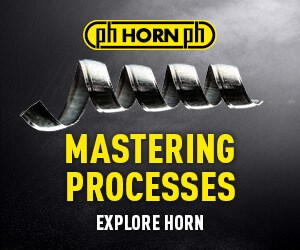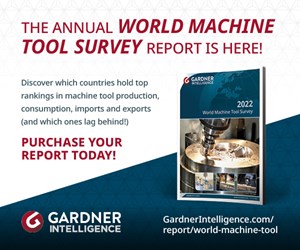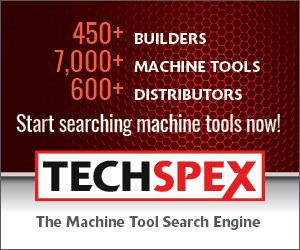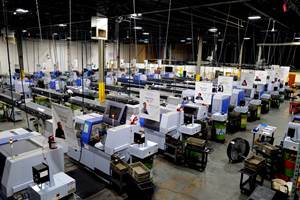Labor, Compliance and Sustainability Strategies
With the right tools, including ERP software, overcoming this “manufacturing trifecta” of challenges is within reach.

With the right tools, including ERP software, overcoming challenges such as workforce, industry compliance and sustainability strategies are within reach. Source: ECI Software Solutions.
The manufacturing ecosystem continues to grow in complexity. Manufacturers face new regulations left and right, with Cybersecurity Maturity Model Certification (CMMC) and International Traffic in Arms Regulations (ITAR) both top of mind for many. And as certifications evolve, labor shortages aren’t making anything easier. Plus, manufacturers must consider action surrounding sustainability, which is increasingly becoming a focus for the younger workforce.
These interconnected challenges require a nuanced, data-driven approach to solve. But with the right tools, overcoming this trifecta of challenges is within reach.
Compliance. Pursuing compliance with frameworks such as CMMC or ITAR can be complex. Both require manufacturers to operate on supported software with modern security protocols. The costs alone can be a major hurdle — possibly ranging from $5k to more than $100k — depending on the size of the operation. These expenses stem from increasing required controls, audits, assessments and implementing necessary changes.
Manufacturers must weigh whether the effort, expense and time invested in becoming government-compliant will translate to significant business opportunities. This dilemma is where data-driven decision making becomes crucial. Leveraging enterprise resource planning (ERP) software can empower shop managers to assess the potential return on investment and implement the compliance framework that is right for their business needs.
This decision-making process is well illustrated by a company such as Midway Swiss Turn, a northern Ohio machine shop. Midway Swiss Turn had considerable government contracts, leading it to pursue CMMC compliance. While leveraging a compliant ERP system, it shifted to automated data collection for accounting, machine availability and material stock, which drove exponential growth in both revenue and workforce. As the company grew, it did not need to invest in additional hardware and staff to maintain equipment by utilizing a cloud-based ERP system. These improvements transitioned it into a higher-value operation, making the shift to CMMC compliance smooth and financially sound.
The labor shortage. Undoubtedly, the skilled labor shortage is at the top of manufacturers’ minds. Americans are not searching for manufacturing jobs in the areas that need them the most, leaving vast unfilled positions. The new workforce is also selective about the companies it joins, expecting advancement, growth and innovation. To mitigate these issues, manufacturers should offer a clear path for upward mobility in their companies, providing cross-training and education to upskill their employees. Proactive recruitment is essential, and it is important for manufacturers to stay involved with their local education facilities and community centers to identify potential employees.
Gen Z, dubbed digital natives, grew up with technology inherent to their lives. A research study about Gen Z working habits found that 91% of these workers will take a job that offers technological solutions over a similar job without this offer. The perception of a company is key to getting Gen-Z talent in the door and keeping them, as they value digital-first work environments in which technology is implemented to drive their workflow.
Therefore, manufacturers should implement new technologies that improve the employee experience, so hours aren’t spent on menial tasks such as updating a physical time sheet. Cloud-based ERP solutions enable employees to access data from anywhere, facilitating remote work. They also feature user-friendly interfaces familiar to Gen Z, which is attractive for retaining talent.
ERP solutions can also ensure that no institutional knowledge is lost as legacy employees leave by storing notes on processes and customer preferences. This can ensure a smooth onboarding process for new employees and that no mistakes are repeated. By aligning recruitment strategies with technological innovation, manufacturers can create an attractive ecosystem for the emerging workforce.
Sustainability. Another avenue to attract and retain Gen Z talent is through sustainability initiatives. Deloitte found that 20% of this generation have changed jobs or industries because of environmental concerns and another 26% plan to do so. Sustainability is not just an environmental imperative but also a critical component of employer branding and talent acquisition. Manufacturers should consider this as they enter the next wave of recruitment and play into their strengths.
The manufacturing landscape of 2025 demands a holistic, adaptive approach that seamlessly integrates technological innovation, workforce development and strategic compliance. By embracing digital transformation through tools such as ERP systems, manufacturers can simultaneously address regulatory compliance, talent retention and sustainability. The key lies in strategically leveraging digital solutions that empower employees, optimize processes and create a forward-thinking organizational culture.
About the Author
Tim Watkins
Tim Watkins is vice president of integrated solutions, ECI Software Solutions.
Related Content
Piezoelectric Sensor Technology: Moving Toward more Efficient Machine Monitoring
A new system that uses simple and compact force or strain sensors, which can be integrated inside toolholders or mounted on surfaces such as spindle housings, can facilitate CNC machine monitoring.
Read MorePrecision Machining Technology Review October 2023
Production Machining’s October 2023 technology showcase includes some of the latest technology from Tungaloy-NTK America Inc., Renishaw, Walter USA, Seco Tools and Haimer USA.
Read MoreInside the Premium Machine Shop Making Fasteners
AMPG can’t help but take risks — its management doesn’t know how to run machines. But these risks have enabled it to become a runaway success in its market.
Read MoreThe Value of RFID Machine Operator Authentication
Can secure shopfloor employee authentication via radio frequency identification enable shops to optimize their data-driven manufacturing efforts?
Read MoreRead Next
The Lost Art of Mastery
There is value to honing and mastering a craft. But it takes time and experience.
Read MoreApproach PMTS 2025 With a ‘Process’ Mindset
High-volume machining operations are more apt to think about the entire process of producing parts beyond the machine tools themselves. All such technology is presented at the 2025 edition of the Precision Machining Technology Show.
Read MoreA Tooling Workshop Worth a Visit
Marubeni Citizen-Cincom’s tooling and accessory workshop offers a chance to learn more about ancillary devices that can boost machining efficiency and capability.
Read More






















